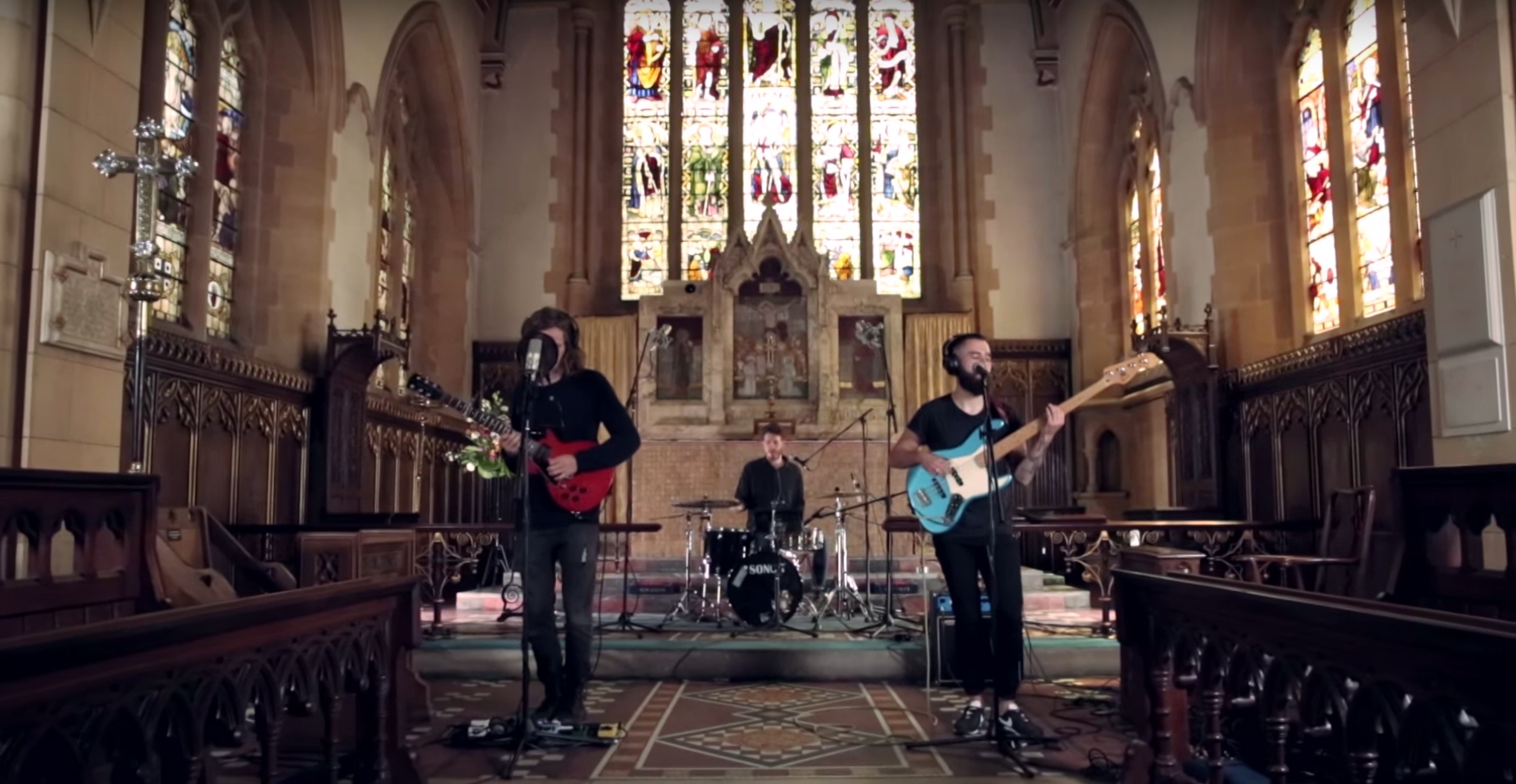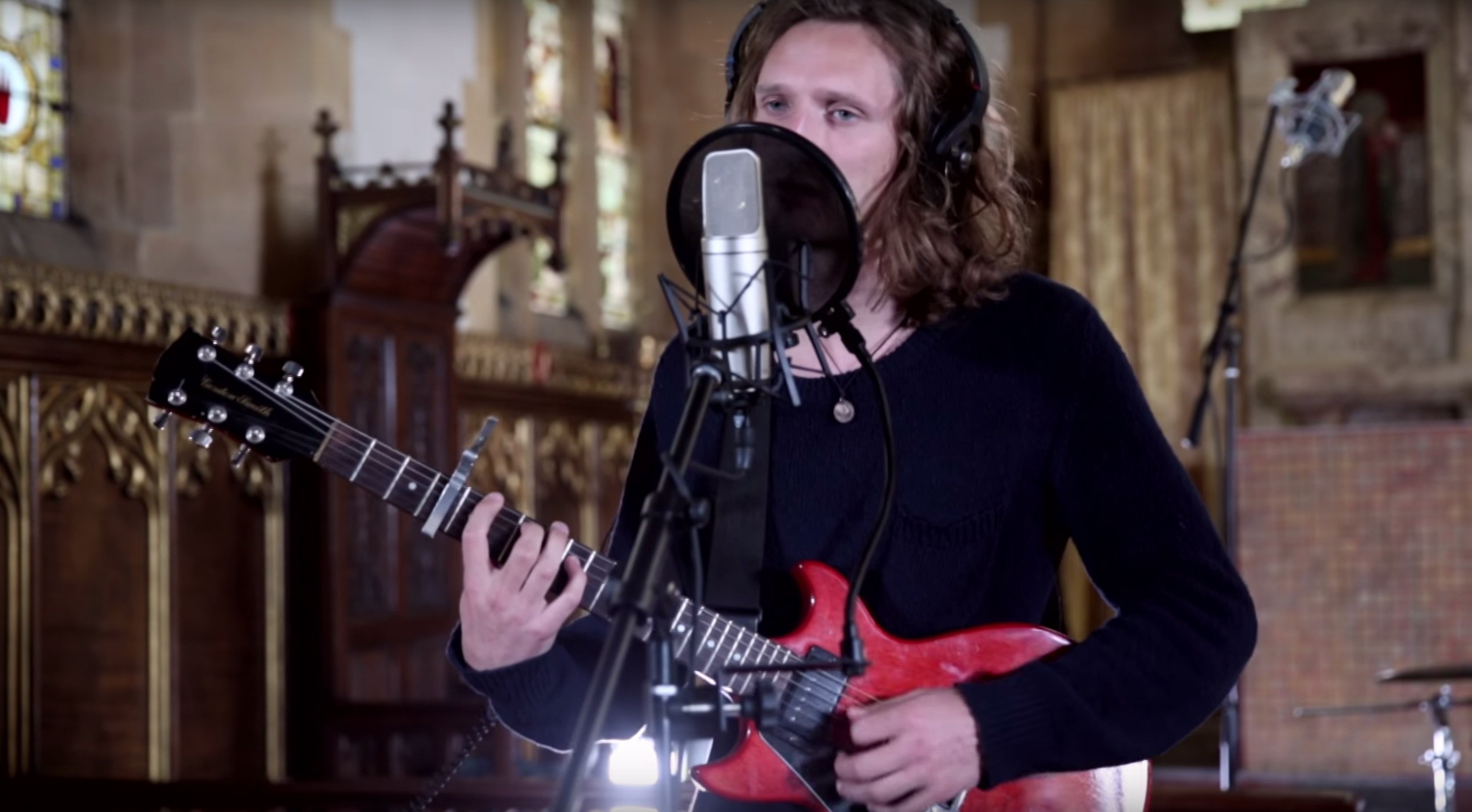Recording a Dynamic Three-Piece
Though Banfi’s lineup looks stripped-down at first glance, the three musicians from London maximise their sound in many ways. From full vocal harmonies to triggered synth samples and stereo guitar effects, the sound they achieve live contains everything you’d expect to hear from a studio record. In this piece, we lift the lid on the Banfi session we recorded live with a Focusrite Scarlett 18i8 and OctoPre MkII Dynamic, on location at a beautiful church near the Focusrite HQ in Buckinghamshire, UK.
Though it’s not totally unique, Banfi have one obvious trick up their sleeves: all three members of the band sing while playing, which is a skill that so many musicians envy. This dexterity allows them to create rich vocal harmonies live, while still maintaining the solid, focussed sound of a three-piece guitar/bass/drums rhythm section.
In addition to this band-wide deftness, drummer Aaron Graham triggers atmospheric synth tracks from his SPD sampling drum pad, which thicken the sonic texture of their live mix. A click track, also from the SPD, allows him to keep timing tight through the course of the song. Lush stereo effects from lead singer/guitarist Joe Banfi’s pedalboard provide a range of guitar tones to give presence to plucked melodies and bring out the nuances in his harmonic chordal work. But Joe plays without an amp, which keeps spill at a minimum, but necessitates a custom headphone mixes and close collaboration with the recording engineer.

For the Focusrite church session, we recorded Banfi live, without overdubs. Every engineer will tell you that a band sounds tightest when the players are performing together, locked in the groove, and because Banfi’s live sound is so complete, it made perfect sense. But, while recording this way is fairly common, the band’s lineup posed several technical challenges on the session.
The first hurdle to overcome was the mix of live and electronic sources. The acoustic drums and bass guitar amp, obviously, create a lot of sound. The synth tracks triggered from Aaron’s SPD and Joe’s guitar pedalboard, on the other hand, need to be sent to the in-ear feeds of the musicians in order to be heard. Same goes for vocals, which also need to be routed to in-ear mixes with no timing delays. For this reason, very-low-latency monitoring was critical in order for the band to be able to hear the full mix without off-putting timing discrepancies.
The solution to the monitoring problem was simple: Scarlett MixControl. This free routing/mixing application comes with the Scarlett 18i8 and allows you to create custom mixes of the audio inputs using on-board DSP mixing. Artist mixes can be routed to the headphones outputs without incurring the round-trip involved in going in to and out of the computer’s audio driver and the DAW: the MixControl audio never leaves the interface, and is therefore completely free of latency.

Another challenge was capturing the number of audio sources. Three vocals, a full set of drumkit mics, stereo guitar, stereo drum pad (for the synths), room mics and a bass guitar added up to a total of 14 inputs. In a normal studio environment, this wouldn’t pose too much of a problem, but in the semi-portable domain of this mobile recording, the equipment had to be baggable and quickly assembled. The Focusrite team chose the Scarlett 18i8 for its portability and expansion options: with an ADAT input, the Scarlett 18i8 can accept an additional eight mono inputs (at 48kHz; four at 96kHz) via an optical digital connection. To supply this expansion, the team chose the Focusrite OctoPre MkII Dynamic. It has eight channels of mic preamps and compression, with outputs on ADAT, which connect directly to the Scarlett 18i8.
The sonic characteristics of the church also posed some challenges. While large reverberant spaces sound lovely for choral music, organ recitals and the like, the sounds of a band can soon become an uncontrolled wash of sound if careful attention is not paid to the sonic activity in the space. So in the Banfi session, some creative audio engineering was required to ensure the recording wasn’t overwhelmed by the sound of the space. To manage the live atmosphere in the church, the recording team made deliberate mic choices to minimise spill and maximise the benefits of having the live-sounding church.
For starters, dynamic mics were chosen for the two backing vocal mics (for drummer Aaron and bassist Chris). Dynamic mics tend to have a low sensitivity, meaning the sound source needs to be close and relatively loud to be picked up. But the aim wasn’t to avoid the sound of the church altogether. The ’big room’ effect sounds magic on drums, so the drum kit was miked using a combination of close, dynamic mics (on kick, snare, and floor tom) and condenser mics for the stereo pair of high overheads, which were carefully spaced with the snare drum at the centre point to avoid phase issues. For Joe’s main vocal, a condenser mic was chosen here too. Condensers generally have a clearer top-end response, and capture an overall more crisp and clear sound, so the compromise between spill and vocal clarity was carefully balanced by the recording team. Condensers, however, are prone to wind pops called plosives, caused when the singer makes ‘B’ and ‘P’ sounds while singing.

A note on digital connectivity. The unavoidable rule when connecting two pieces of digital equipment is that they must share the same clock signal, with only one device acting as the clock master. If the clock is not configured properly, the audio will have audible glitches that will render your recordings completely unusable. On the Banfi session, we had only one option in terms of clocking: to use the OctoPre MkII Dynamic as the master clock and configure the Scarlett 18i8 to ‘slave’ from the incoming clock signal, which is transmitted over the optical ADAT cable. This is all achieved by simply selecting the appropriate clock source in Scarlett MixControl. It’e best practice to do this before you open your DAW and start recording.
In summary, the Banfi recording shows that, with some considered engineering decisions and a modest amount of recording equipment, excellent-sound recordings can be made in a range of environments. Where will your next recording session be?
